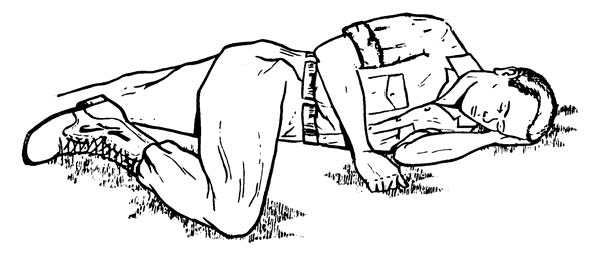Cardiopulmonary Resuscitation
LESSON 3: INITIATE RESCUE BREATHING ON AN ADULT
3-8
3-8. EVALUATE YOUR FINDINGS
a. If your check shows that the casualty is not breathing, try to open his airway again and check for breathing a second time. If he is still not breathing, begin administering ventilations immediately (paragraph 3-9).
b. If your check shows that the casualty is breathing, asses the rate and quality of breathing. Just because a casualty is breathing does not ensure that the depth of breathing or the rate are adequate to support life. (If the casualty is breathing 4 times per minute, he is technically breathing; but this rate is not adequate to sustain the casualty's life). If the casualty has adequate breathing, consider inserting an airway adjunct to help control and protect the casualty's airway. If available, oxygen should be administered at this time. Continue to examine the casualty for injuries while maintaining his airway. Check on his breathing periodically. Reopen the airway and perform rescue breathing should the casualty stop breathing.
(1) If the casualty regains consciousness, place him in the left lateral recumbent position (figure 3-5) if no other injuries are present.
Figure 3-5. Unconscious casualty in the left lateral recumbent position.
(2) If the casualty is unconscious and you have an oropharyngeal airway (OPA or J-tube) available, you can insert the airway to prevent the casualty's airway from being blocked by his tongue. Remove the airway when the casualty begins to regain consciousness.
(a) Make sure that you insert the correct size of airway. Place the oropharyngeal airway along the outside of the casualty's jaw. The airway should reach from the bottom tip of his ear to the corner of his mouth.
(b) Open the casualty's mouth. If you have difficulty in opening his mouth, place your crossed thumb and index finger on the casualty's upper and lower teeth near a corner of his mouth and push until his teeth separate and his mouth opens.
(c) Place the tip end (not the flanged end) of the oropharyngeal airway into the casualty's mouth so that the tip points toward the roof of the casualty's mouth.
(d) Slide the airway along the natural curvature of the tongue.
(e) When the tip of the airway reaches the back of the tongue past the soft palate, rotate the airway 180 degrees so the tip of the airway points down toward his throat.
(f) Advance the airway until the flange rests on the casualty's lips.
(3) If the casualty has an intact gag reflex but can still not protect his airway, insert a nasopharyngeal airway.
(a) Ensure the airway is the correct size by measuring the diameter of the airway with the patient's fifth finger (pinky) and the correct length by measuring the airway from the corner of the patientís nostril to the tip of the ear.
(b) Lubricate the airway.
(c) Insert the airway in to the patientís right nostril with the bevel towards the septum. This is anatomically the larger nostril in most people, and the curve of the airway is designed to be inserted in this side. Insert the airway by pushing it towards the back of the patient's head until the flange rests on the casualtyís nare.


